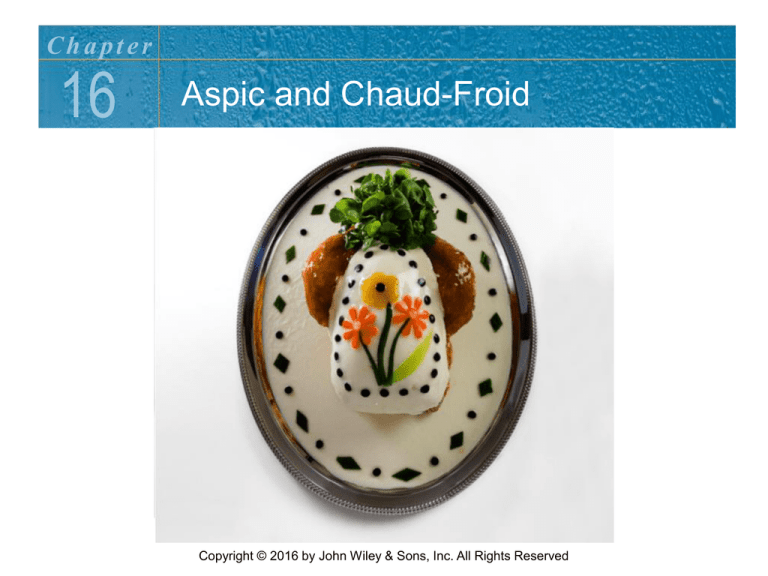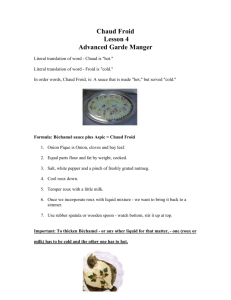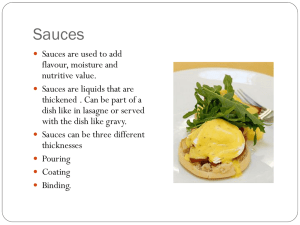
Chapter
16
Aspic and Chaud-Froid
Copyright © 2016 by John Wiley & Sons, Inc. All Rights Reserved
Chapter
16
Aspic and Chaud-Froid
Chapter Pre-Requisites
Before Studying this chapter, you should already:
• Have read “How to Use This Book,” pages xxviii-xxxiii,
and understand the professional recipe format.
• Have read Chapter 6, “Cold Seafood,” and Chapter 7,
“Cold Meats,” and know how to prepare these foods for
cold service.
• Be proficient at preparing and clarifying stock.
• Be proficient at preparing velouté and demi-glace sauce.
Copyright © 2016 by John Wiley & Sons, Inc. All Rights Reserved
Chapter
16
Aspic and Chaud-Froid
Chapter Objectives
After reading this chapter, you should be able to:
• Use granular gelatin to properly gelatinize liquids into preparations
of varying consistencies.
• Prepare aspics, chaud-froid sauces, and mayonnaise collée.
• Set up an efficient aspic and chaud-froid workspace.
• Prepare various foods for coating.
• Prepare and fabricate vegetables, fruits, and herbs for surface
décor.
• Coat foods with aspic, chaud-froid, and mayonnaise collée, and
decorate them with attractive designs.
• Prepare various dishes that are bound or molded with aspic, chaudfroid, and mayonnaise collée.
Copyright © 2016 by John Wiley & Sons, Inc. All Rights Reserved
Chapter
16
Aspic and Chaud-Froid
The Challenge of Aspic and Chaud-Froid Work
Understanding Coating Sauces
• A coating sauce is a dressing for cold food that is fluid
when warm but sets up into a gel when chilled.
– Aspic
: Clarified, seasoned stock with the addition of gelatin.
– Chaud-froid
: A cream velouté sauce or demi-glace sauce
with the addition of aspic.
– Mayonnaise collée : Consists of thick mayonnaise and aspic,
and is frequently used in place of chaud-froid.
Copyright © 2016 by John Wiley & Sons, Inc. All Rights Reserved
Chapter
16
Aspic and Chaud-Froid
The Challenge of Aspic and Chaud-Froid Work
Understanding Coating Sauces
• Coating sauces gel because they contain a high
proportion of gelatin.
– Traditional stocks were made with a high proportion of bones,
meat, and connective tissue and were simmered for many hours.
• Today, most garde manger chefs use standard stocks of
lighter consistency to make these sauces.
• Therefore, it is necessary to fortify, or strengthen, the
gelatin content by adding commercial gelatin.
Copyright © 2016 by John Wiley & Sons, Inc. All Rights Reserved
Chapter
16
Aspic and Chaud-Froid
The Challenge of Aspic and Chaud-Froid Work
Understanding Gelatin
• Gelatin: A nearly colorless and flavorless water-soluble
substance derived from collagen.
– Collagen: an animal protein found in bones, cartilage, connective
tissue, and hides.
• Protein gel: collagen, when combined with water in the
correct way, forms a protein net that captures the water.
• Unflavored dry gelatin: liquid gelatin from which the
water is removed and purified of most of its meat flavor
and odor.
Copyright © 2016 by John Wiley & Sons, Inc. All Rights Reserved
Chapter
16
Aspic and Chaud-Froid
The Challenge of Aspic and Chaud-Froid Work
Understanding Gelatin
• Blooming: Rehydrating dry gelatin before use.
– When gelatin comes into contact with cool water or a water-based
liquid, it absorbs the liquid and expands.
– When you rehydrate gelatin, you are said to “bloom” it.
• When this liquid is chilled, the protein gel forms and the liquid is said
to have set. The degree of firmness to which the liquid gels is called
its set.
Copyright © 2016 by John Wiley & Sons, Inc. All Rights Reserved
Chapter
16
Aspic and Chaud-Froid
The Challenge of Aspic and Chaud-Froid Work
Understanding Gelatin
• Gelatin is available in two market forms. Each form
requires a different blooming procedure.
1. Gelatin powder: Dehydrated liquid gelatin that is ground into fine
granules.
a) Granular gelatin is bloomed by mixing it with a cold liquid in a ratio
of roughly 1 part gelatin to 4 parts liquid by volume.
2. Sheet gelatin: Thin, brittle sheets of translucent gelatin made by
pouring liquid gelatin into very shallow trays, dehydrating it into a
film-like later, then cutting it into rectangular pieces.
Copyright © 2016 by John Wiley & Sons, Inc. All Rights Reserved
Chapter
16
Aspic and Chaud-Froid
The Challenge of Aspic and Chaud-Froid Work
Preparing and Using a Gelatinized Liquid
• Gelatin is used to thicken, or gelatinize, a liquid. Its preparation is a
four-step process.
–
–
–
–
Step 1: Determine the gelatin-to-liquid ratio
Step 2: Bloom the gelatin
Step 3: Dissolve the bloomed gelatin in the liquid
Step 4: Cool the gelatinized liquid to working consistency
Cooling gelatinized
liquid to working
consistency.
Copyright © 2016 by John Wiley & Sons, Inc. All Rights Reserved
Chapter
16
Aspic and Chaud-Froid
Aspic
• Aspic: A translucent, gelatinized coating that adds sparkle and shine
to the products it enhances.
– In French it is called aspic gelée
.
– It was originally used to form a protective barrier on foods that were set
out on buffet tables for lengthy periods.
– In classical cuisine, true aspic gelée begins with gelée de viande
, or
meat jelly.
– Meat jelly: Term used to describe stocks and meat-cooking juices that
have enough natural gelatin to gel when chilled. These cannot be called
aspics until they are clarified and seasoned.
Copyright © 2016 by John Wiley & Sons, Inc. All Rights Reserved
Chapter
16
Aspic and Chaud-Froid
Aspic
Preparing Aspic
• There are four steps in the preparation of aspic.
–
–
–
–
Step 1: Obtain the Stock
Step 2: Clarify the Stock
Step 3: Season the Clarified Stock
Step 4: Add the Gelatin
Copyright © 2016 by John Wiley & Sons, Inc. All Rights Reserved
Chapter
16
Aspic and Chaud-Froid
Chaud-Froid
• Chaud-froid is an opaque coating sauce used to mask
foods.
– To mask means to cover a food in such a way that its surface is
no longer visible.
– For this reason, the two opaque coating sauces, chaud-froid and
mayonnaise collée, are also called masking sauces.
• The French name chaud-froid literally means “hot-cold,”
referring to the fact that the sauce is made hot but served
cold.
Copyright © 2016 by John Wiley & Sons, Inc. All Rights Reserved
Chapter
16
Aspic and Chaud-Froid
Chaud-Froid
• The term chaud-froid actually has two meanings: It
describes a dish of food coated in chaud-froid sauce and
also the coating sauce itself.
• Today, chaud-froid sauce is primarily used for coating
previously cooked and cooled foods and, thus, is
prepared separately.
• Like aspics, chaud-froid sauces are classified both by
their color and by the stock that was used to make their
base sauce.
Copyright © 2016 by John Wiley & Sons, Inc. All Rights Reserved
Chapter
16
Aspic and Chaud-Froid
Chaud-Froid
Preparing Chaud-Froid Sauces
• The preparation of chaud-froid sauce requires the
combination of two stock base products.
• It is a multistep procedure:
–
–
–
–
–
Step 1: Obtain the Stock
Step 2: Prepare the Base Sauce
Step 3: Prepare the Aspic
Step 4: Add the Aspic (and Cream)
Step 5: Strain
Copyright © 2016 by John Wiley & Sons, Inc. All Rights Reserved
Chapter
16
Aspic and Chaud-Froid
Mayonnaise Collée
• The French word coller means “to stick” or “to adhere.”
• Thus, mayonnaise collée is a mayonnaise sauce that has had
gelatin added to it so it will stick to food and form a coating.
• The basic ratio for preparing mayonnaise collée is: 2 parts thick
mayonnaise to 1 part aspic for coating, measured by volume.
Copyright © 2016 by John Wiley & Sons, Inc. All Rights Reserved
Chapter
16
Aspic and Chaud-Froid
Aspic and Chaud-Froid Work
• There is almost no limit to the types of
cold foods that may be coated with
aspic or chaud-froid.
• In general, foods that are naturally
colorful and attractive are coated with
aspic only.
• Both large and small cold food items
are coated with aspic and chaud-froid.
• A large, whole roasted turkey breast or
baked ham may be coated with chaudfroid.
Copyright © 2016 by John Wiley & Sons, Inc. All Rights Reserved
Chapter
16
Aspic and Chaud-Froid
Aspic and Chaud-Froid Work
Steps in Basic Coating and Decorating Work
• Coating foods with aspic and chaud-froid or mayonnaise collée is a
multi-step procedure that is usually done over a period of two or
more days.
• The basic steps necessary to achieve a finished dish:
1. Fabricate, cook, and chill the food items to be coated.
2. Prepare the coating sauces.
3. Prepare the surface décor items.
4. Skin, trim, or otherwise prepare the food to receive the coating.
Copyright © 2016 by John Wiley & Sons, Inc. All Rights Reserved
Chapter
16
Aspic and Chaud-Froid
Aspic and Chaud-Froid Work
Steps in Basic Coating and Decorating Work
1.
2.
3.
4.
5.
6.
7.
8.
Fabricate, cook, and chill the food items to be coated.
Prepare the coating sauces.
Prepare the surface décor items.
Skin, trim, or otherwise prepare the food to receive
the coating.
Apply one or more base coats to the food item.
Apply the surface décor items to the food item.
Apply an aspic finish coat to the food item.
Add décor to the plate or presentation platter.
Copyright © 2016 by John Wiley & Sons, Inc. All Rights Reserved
Chapter
16
Aspic and Chaud-Froid
Surface Décor for Aspic and Chaud-Froid Work
Surface Décor is applied to the surface of a coated food.
• It is also called Flat Décor.
• Surface décor must be edible and is meant to be eaten along with
the coated food.
• These décor items are usually crafted from vegetables.
• Some can be used as is, without cooking.
• Others must be blanched and refreshed to soften them and improve
their flavor.
Copyright © 2016 by John Wiley & Sons, Inc. All Rights Reserved
Chapter
16
Aspic and Chaud-Froid
Surface Décor for Aspic and Chaud-Froid Work
Guidelines for Setting Up an Aspic and Chaud-Froid
Workspace
• Have plenty of room to work.
• Clear enough space in a nearby refrigerator to accommodate your
food item(s) and the serving platter(s).
• Assemble your complete equipment mise en place before
beginning.
• All equipment must be clean and grease-free. Double-check the
cleanliness of sheet trays and racks so they do not contaminate the
excess coating sauces that drip onto them.
Copyright © 2016 by John Wiley & Sons, Inc. All Rights Reserved
Chapter
16
Aspic and Chaud-Froid
Surface Décor for Aspic and Chaud-Froid Work
Guidelines for Setting Up an Aspic and Chaud-Froid
Workspace
• Place a bus tub for used equipment on the under shelf of your
worktable.
• Have plenty of ice on hand for cooling your coating sauces.
• If your work area is far from the stove, set up a rechaud
, or
portable butane burner, on the worktable for rewarming coating
sauces.
• Have all coating sauces, décor items, and other ingredients ready
and close at hand.
• Place your design template in a page protector, or cover it with
plastic film, to keep it clean for future use.
Copyright © 2016 by John Wiley & Sons, Inc. All Rights Reserved
Chapter
16
Aspic and Chaud-Froid
Surface Décor for Aspic and Chaud-Froid Work
Other Applications for Coating Sauces
Aspic may be used to bind the layers of a
vegetable or seafood terrine.
Aspic or mayonnaise collée may be used to
bind a complex salad so it can be formed and
unmolded.
Copyright © 2016 by John Wiley & Sons, Inc. All Rights Reserved











